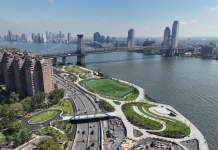The fight over Pier 36 on the East River – raging since the Dinkins Administration – is heating up once again. This month, neighborhood organizations began new talks with Basketball City, the private company granted a 20 (plus) year lease for part of the pier. They want assurances that the community will have access to the facility, that membership fees will be discounted and that the company will hire local residents.
The organizations, including the Two Bridges Neighborhood Council and Good Old Lower East Side (GOLES), fought a long battle to keep Basketball City from occupying the waterfront. Citing a 1994 agreement requiring Pier 36 to be “permanently dedicated for use by the community as a community recreation facility,” they opposed the city’s decision to go ahead with a lease to the for-profit company (a bid was first submitted in 1996). But, with support from Community Board 3, the deal went through — although promises were made that Basketball City would provide certain free and discounted services to the community.
Now, as Basketball City makes plans to refurbish a section of the pier for an opening later this year, the groups are determined to make sure they get what was promised. Two Bridges recently sent a letter to supporters saying, “…the whole affair demonstrates an egregious indifference to the youth and families of our community.” It urges residents to contact elected officials and community board members and sign an online petition. The organizations are planning an “All-LES Basketball Tournament” on August 29th at the Henry M. Jackson Playground on Henry Street. A flier for the event says, “The City is taking the People’s Land… and turning it into a huge private gym.” It continues, “All we need is two hoops, some pavement and a ball.”
But even as the groups mobilize their supporters, they have already held one meeting with Basketball City owner Bruce Radler, and more negotiations are scheduled. Contacted by The Lo-Down, Radler said he was surprised by the letter, given the fact that talks are ongoing. He emphasized that part of Basketball City’s mission is to “give back to the community” and he’s committed to honoring the promises that were made. Radler acknowledged, however, that the details still needed to be worked out.
In response, Damaris Reyes, executive director of GOLES, said, “I’m shocked to hear that he’s surprised because the letter is not crazy. The letter is simply letting people know that this is what is going on… There’s this thought that, well, if you sit down at the table and you negotiate then you have to stop everything you’re doing. Our commitment and our responsibility is first to our community.” Reyes says she’s encouraged that Radler “seems willing to talk about these things.” But she added, “We think that it’s all pretty loose. He’s expressed to us his commitment to… make it beneficial for the community but we feel we need some real assurances on what does that look like. Your idea of what is going to benefit my community is not necessarily my idea of what is going to benefit my community.”
The letter from Two Bridges calls on Basketball City to:
- Hire local residents for the facility
- Offer discounted yearly membership fees
- Offer discounted daily open play fees
- Construct community rooms for use by local non-profit organizations and schools at no charge
Radler said he’s looking to hire locally. He says Basketball City does not have yearly memberships but he’s willing to discount court fees for local residents. He indicated changes required by the city eliminated all but one community room but he would make it available for community meetings and events. Radler noted that his company has a stellar track record on the West Side and in Boston, where it’s been operating for more than a decade. He said a free camp in Harlem and a scholarship program for kids in Downtown Manhattan demonstrate the facilities are not just about upscale corporate clients who can afford full court fees.
When the Community Board debated the Basketball City deal in 2007, neighborhood activists pointed out that even discounted fees would be out of reach for most residents in the neighborhood, where the average income is barely over $20,000 a year. But others argued the deal was the best that could be hoped for. Board member David Crane said, “If we vote ‘No,’ the higher levels of government would pass it and we
would lose the stipulations. The city does not fund its Parks
Department very well. This is a way for us to get a facility,” he said. This week, Reyes told us the Community Board is “not the only voice of this community. They have their role and we respect that, and we have our role and we have the right and the ability to go deeper if we choose to do that, and that is what we are going to do.”
The Lo-Down will have more on the Basketball City story soon. We’ll be talking to community organizations on the West Side about their experiences with the company. And, of course, we’ll follow the ongoing negotiations.









